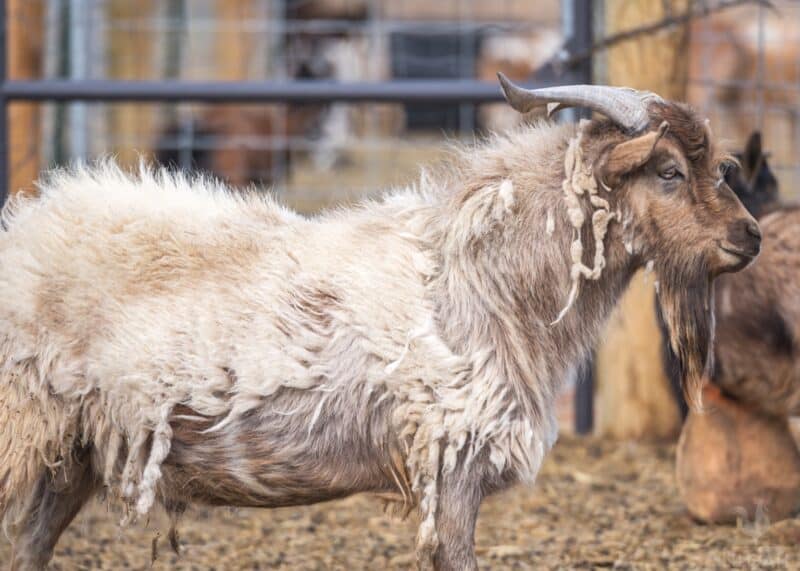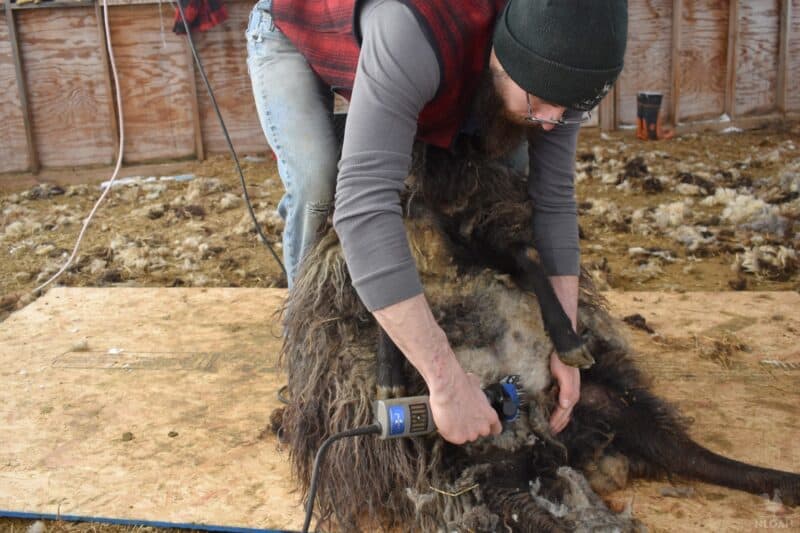Pretty much everyone, even people who didn’t grow up on a farm, know that sheep must be sheared of their wool.
That is the only way to get it off of them to turn it into useful clothing, of course, but it’s also essential for the wellbeing of the sheep since they don’t lose it naturally.

But did you know that wild sheep shed their wool without the help of humans? It’s true! But that brings up a good question: How did sheep ever shed their wool before they were domesticated?
Wild sheep shed their wool naturally via shedding, and by rubbing against convenient surfaces like rocks, cliff faces and trees.
Fascinating stuff, and it makes sense, but wild sheep definitely do what most domestic sheep can’t.
In fact, domestic sheep are almost entirely dependent on people to remove their wool, or else it will become a big problem.
In this article, I’ll tell you how sheep adapted to shed their own wool before being domesticated by humans, and also look more into their wool overall…
Domestic Sheep Must Be Sheared to Prevent Problems
The vast majority of domestic sheep require regular shearing as part of their overall care routine, not just for the production of wool.
Shearing is simply the process of removing the wool from a sheep’s body, like a haircut.
This has it has many benefits for the animal’s wellbeing, and neglecting to shear a sheep can lead to several increasingly serious problems, ones we will talk about in one minute.
When sheep are not shorn, they become overly woolly and their fleece becomes denser and ever more matted, which makes it difficult and tiring for them to just move around.
This can also lead to major heat stress, especially in hot climates.
Aside from preventing health issues, regular shearing also promotes healthy fleece growth, and improves the overall quality of the wool.
A well-shorn sheep can produce higher-quality wool that is better for use in textiles and other products.
Shearing also helps to prevent the buildup of dirt and debris within the fleece, which can reduce the value of the wool and make it less desirable to buyers.
What Happens if You Don’t Shear a Sheep?
Neglecting to shear a sheep is virtually dooming it to a sick, painful and miserable existence.
If a sheep is not sheared regularly, it can suffer from a variety of health problems and diseases aside from being prone to heatstroke in hot weather.
As mentioned earlier, the wool can become matted and dense, making it difficult for the sheep to move around.
Wool is surprisingly heavy, and when packed with dirt or mud or drenched in water, it can weigh a ton!
In addition, the wool can more easily become infested with parasites, such as lice and ticks, which can cause further health problems for the animal.
It also has a nasty tendency to become fouled with urine and feces, and then lay against the poor sheep’s skin, greatly accelerating lesions and other conditions.
Over time, the wool will continue to grow and become thicker and thicker, leading to a condition known as wool blindness.
This occurs when the wool grows over the sheep’s eyes, obstructing its vision and causing the animal to become disoriented.
In severe cases, wool blindness can result in the death of the animal from mishap, as it becomes unable to navigate its environment or find food and water.
For all of these reasons, failure to shear a sheep will inevitably have dire consequences for the animal’s health and well-being.
It’s critical to conduct regular shearing for almost all domestic sheep species.

Humans Bred Sheep for Wool Retention Over the Centuries
Isn’t it sad that sheep are totally dependent on us for shearing? How did this ever come to be. That part, at least, is easy to explain.
Humans have been breeding sheep for thousands of years, and one of the primary reasons for this breeding has been to improve the quality and quantity of wool that the animals produce.
Over time, humans have selectively bred sheep with desirable wool characteristics, such as length, strength, and softness, while culling those with less desirable traits.
Selective breeding has also allowed humans to create breeds of sheep that are better adapted to different climates and environments.
Some sheep breeds are well-suited for cold, wet climates, while others thrive in hot, arid environments.
This has allowed humans to raise sheep in a wide range of locations around the world, making wool production a truly global industry.
And among all of these many, many domestic breeds of sheep, there is one characteristic that was selected for time and time again: wool retention.
Because of this, domestic sheep don’t drop their wool on their own. It makes sense, for sure, because if you are raising sheep for their wool you don’t want it falling off of them in clumps over time!
But the downside to all this breeding is that most domestic breeds of sheep are now unable to shed their wool on their own in any meaningful way.
Or at least shed enough, and quickly enough, to prevent all the issues I talked about…
Wild Sheep Still Shed Their Wool Naturally
But unlike domestic sheep, which require regular shearing to manage their wool growth, their wild sheep cousins evolved to shed their wool naturally and still do so to this very day.
If they didn’t, they would likely be extinct by now!
This process is known as molting, and allows wild sheep to shed their coats all on their own in the spring and summer.
While wild sheep may still require some grooming or maintenance of their coats, this is also done without our help; the sheep handle it on their own via natural behaviors such as rubbing against trees or rocks.
Why Do Wild Sheep Lose Their Wool?
A yearly molt allows wild sheep to maintain their natural insulation against cold when they need it, and get rid of it to stay cooler when they don’t.
This shedding of the winter coat helps wild sheep adapt to changing environmental conditions, as they prepare for warmer weather.
Ultimately, they remain pretty comfortable in their natural environments year-round. And they do this without the need for human intervention!
During the molting process, the old wool is gradually replaced by new growth continually, which is typically lighter and less dense.
To help the process along, wild sheep will scratch and scratch on any convenient surface, rubbing back and forth to dislodge old wool in big chunks alongside what just falls out as shed.
Are There Any Domestic Sheep Breeds That Don’t Need Shearing?
While most domestic sheep breeds require regular shearing to manage their wool growth, there are a few exceptions.
These breeds have been selectively bred over time to produce wool that still sheds naturally, eliminating or greatly reducing the requirement of shearing for health, at least.
These domestic breeds are known as “hair sheep” as opposed to wool sheep.
One example of a well-known domestic sheep breed that does not require shearing is the Barbados Blackbelly sheep, which is native to the Caribbean and came around as the result of British cross-breeding efforts.
This breed has a short, coarse coat that sheds naturally, making it well-suited to hot and humid climates.
Another breed that doesn’t require shearing is the Katahdin. Created in Maine during the middle of the 20th century, this breed is known for being smooth haired, healthy and hardy.
Another is the South African Dorper, known more for its excellent leather than its sparsely wooly and naturally shedding coat. These are some of the best sheep for hot climates.
These are just a few examples, and there are several other hair sheep that don’t need shearing.
But most domestic sheep do, and most of the hair breeds are relatively rare and may not be as well-suited to most environments or common uses as our standard wool breeds.
Make sure you research them well before you invest on a whim.
Tom has lived and worked on farms and homesteads from the Carolinas to Kentucky and beyond. He is passionate about helping people prepare for tough times by embracing lifestyles of self-sufficiency.
